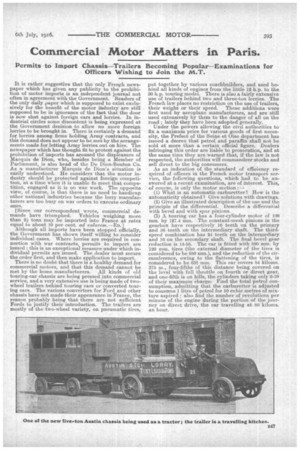Commercial Motor Matters in Paris.
Page 15

If you've noticed an error in this article please click here to report it so we can fix it.
Permits to Import Chassis—Trailers Becoming Popular—Examinations for Officers Wishing to Join the M.T.
It is rather suggestive that the only French newspaper which has given any publicity to the prohibition of motor imports is an independent journal not often in agreement with the Government. Readers of the only daily paper which is supposed to exist exclusively for the benefit of the motor industry are still supposed to be in ignorance of the fact that the door is now shut against foreign cars and lorries. In industrial circles some discontent is being expressed at the Government decision to allow no more foreign lorries to be brought in. There is certainly a demand for lorries among firms holding Army contracts, and this demand does not appear to be met by the arrangements made for letting Army lorries out on hire. The newspaper which has thought fit to protest against the prohibition of imports has aroused the displeasure of Marquis de Dion, who, besides being a Member of Parliament, is also head of the De Dion-Bouton Co. As a manufacturer Marquis de Dion's situation is easily understood. He considers that the motor industry should be protected against foreign competition, at a time when it is unable to meet that competition, engaged as it is on war work. The opposite view, of course, is that there is no need to handicap other national industries because the lorry manufacturers are too busy on war orders to execute ordinary ones.
[ Since our correspondent wrote, commercial demands have triumphed. Vehicles weighing more than WI tons may be imported into France at rates equal to about 10 per cent, ad valorem. —En.'
Although all imports have been stopped officially, the Government has shown itself willing to consider individual cases. Where lorries are required in connection with war contracts, permits to import are issued ; this is an exceptional measure under which individual permits are issued. The dealer must secure the order first, and then make application to import. There is no doubt that there is a healthy demand for commercial motors, and that this demand cannot be met by the home manufacturers. All kinds of old touring-car chassis are being pressed into commercial service, and a very extensive use is being made of twowheel trailers behind touring cars or converted touring cars. The various converters for Ford and other chassis have not made their appearance in France, the reason probably being that there are not sufficient Fords to justify their introduction. The trailers are mostly of the two-wheel variety, on pneumatic tires, puttogether by various coachbuilders, and used behind all kinds of engines from the little 12 h.p. to the 30 h.p. touring model. There is also a fairly extensive use of trailers behind two and three-ton lorries. • The French law places no restriction on the use of trailers, their weight or their speed. These additions were first used by aeroplane manufacturers, and are still used extensively by them to the danger of all on the road ; lately they have been adopted generally. Under the powers allowing the civil authorities to fix a maximum price for various goods of first necessity, the Prefect of the Seine et Oise department has issued a decree that petrol and paraffin shall not be sold at more than a certain official figure. Dealers infringing this order are liable to prosecution, and at the same time they are warned that, if the law is not respected, the authorities will commandeer stocks and sell direct to the big consumers. As an indication of the standard of efficiency required of officers in the French motor transport service, the following questions, which had to be answered at a recent examination, are of interest. This, of course, is only the motor section : (1) What is an automatic carburetter? How is the automaticity obtained ? Give solutions with drawings. (2) Give an illustrated description of the use and the principle of the differential. Describe a differential with bevel and with spur pinions. (3) A touring car has a four-cylinder motor of 100 mm. by 127.4 mm. The constant-mesh pinions in the gearbox have respectively 16 teeth on the primary and 36 teeth on the intermediary shaft. The thirdspeed combination has 24 teeth on the intermediary and 16 on the secondary shaft. The final bevel gear reduction is 14-56. The car is fitted with 880 ram. by 120 mm. tires (the external diameter of the tires is considered to be 880 ram.), and the reduction of the circumference, owing to the flattening of the tires, is considered to be 63t-min. This car covers 84 Moms. 375 m., four-fifths of this distance being covered on the level with full throttle on fourth or direct gear, and one-fifth is on hills, the cylinders taking only 6-10 of their maximum charges Find the total petrol consumption, admitting that the carburetter is adjusted to consume 1 litre of petrol for 10 cubic metres of mixture aspired ; also find the number of revolutions per minute of the engine during the portion of the journey on direct drive, the car travelling at 80 kiloms. an hour.




















